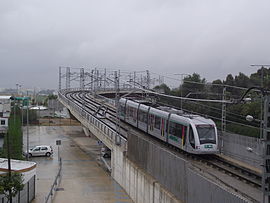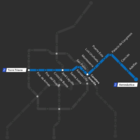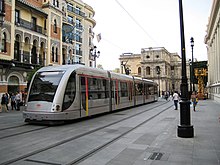Metro Seville
|
|
|
|---|---|
|
Elevated section with railcars of the type CAF Urbos 2
| |
|
Line network of the Seville Metro
| |
| Route length: | 18.2 km |
| Gauge : | 1435 mm ( standard gauge ) |
| Power system : | 750 V = |
| Top speed: | 70 km / h |
The Seville Metro is a four-line light rail network for the Spanish city of Seville , the first line of which opened on April 2, 2009 . The web is the as Metrocentro designated tram connected urban society TUSSAM in the city center.
history
On January 1, 1977, the construction of a metro network with three lines began. In 1983, the work was stopped because of fear of damage to historical buildings. The project was also criticized from an economic point of view, as Seville did not have a large population growth at that time.
Inspired by the construction boom of subways in Spain from 1990 and the dynamic development after Expo 92 , the construction of a metro was taken up again with changed planning. An old section of tunnel between Prado and Avenida de Menéndez Pelayo could be used by line 3 in the future.
When planning the new route, tunneling under the historic old town was avoided. Instead, it is accessed by the tram , the first section of which went into operation in October 2007. A separate operating company was founded to operate the metro.
Expansion and planning
line 1
![]() Ciudad Expo - Olivar de Quinto (Southwest – Southeast)
Ciudad Expo - Olivar de Quinto (Southwest – Southeast)
- Cost: € 428.5 million
- Length: 18.9 km
- Railway stations: 22
- Passengers (expected): 14 million per year

Line 1, 18 km long, runs from the Ciudad Expo exhibition site to the southwest of the center on the west bank of the Guadalquivir, initially primarily above ground. The canalized river is crossed on a bridge, the oxbow lake three stations further east in the tunnel. The route then passes under the city center and turns east of the 1º de Mayo station to the southeast to the Olivar de Quinto terminus in the suburb of Montequinto. Between the Cocheras stations and the end of the route, it again runs largely above ground.
The section from Ciudad Expo to Condequinto - with the exception of the Puerta Jerez and Guadaira stations - went into operation on April 2, 2009, the rest of the line on November 23 of that year. Of the 22 planned stations, 21 are now in operation. 60% of the route and 15 of the 21 stops were laid underground. The outer lines were given a double contact line with an elevated chain, and overhead conductor rails were installed in the tunnel sections . South of the Cocheras stop is the depot with the main workshop and a parking facility.
The Puerta Jerez station, which opened on September 16, 2009, has the largest number of passengers, where you can transfer to and from the tram. The San Bernardo stop is a transfer station for RENFE local trains . Access to the stations via automatic platform screen doors , the 65 m long and 300 mm high platforms are equipped with platform screen doors fitted. The trains are dispatched by the driver using platform cameras and monitors. On weekdays the trains run from 6.30 a.m. to 11 p.m. and on weekends until 2 a.m.
There are plans to switch to two future lines at the Parque de los Príncipes (line 4), Prado (line 3), 1º de Mayo (line 4) stations. A link to the planned line 2 is not yet planned.
A change to the Alcalá de Guadaíra tram is planned at Pablo de Olavide station.
Line 2 (in planning)
![]() Torreblanca-Sevilla Este-Puerto Triana (East – West)
Torreblanca-Sevilla Este-Puerto Triana (East – West)
The planned line 2 is to cross under the city center in an east-west direction. An additional line branch (line 2b) to the airport is planned in the east. You can change at the Torretriana (line 4), Amador de los Ríos (line 3) and Av. Andalucía (line 4) planned.
Line 3 (in planning)
![]() Pino Montano-Los Bermejales (north-south)
Pino Montano-Los Bermejales (north-south)
Line 3 is to cross under the city center from north to south in the future. A change will be possible in Amador de los Ríos (line 2), Prado (line 1) and Reina Mercedes (line 4).
Line 4 (in planning)
![]() Cartuja-Tamarguillo-Reina Mercedes (ring line)
Cartuja-Tamarguillo-Reina Mercedes (ring line)
Line 4 is planned as a ring line around the historic center of the city. It is available at Torretriana (line 2), Parque de los Príncipes (line 1), Reina Mercedes (line 3) and Av. Andalucía (Line 2) allow a direct change. The underground stations C. Hidalgo (Line 1) and Dr. Leal Castaño (line 3) are close to another train station.
vehicles
Low -floor railcars of the type Urbos 2 from Construcciones y Auxiliar de Ferrocarriles (CAF) operate on line 1 in a bidirectional design . They are identical to those of the first generation of the local tram vehicles. After being replaced by Urbos 3 in 2011, the latter were also relocated to the Metro.
These are five-part vehicles that run with single-arm pantographs under an overhead contact line with a DC voltage of 750 V. They are 31.26 m long, 2.65 m wide and 3.39 m high. Their entry height is 350 mm, they have 54 seats and 221 standing places. The eight drive motors have a total output of 560 kW and the maximum speed is 70 km / h.
Initially there were 17 cars, to which the five Urbos 2 trams were added after 2011. Due to the length of the platform, they can operate as double units.






